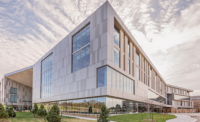F.D. Kuester and A.J. Mihm Generating Stations
Negaunee and Baraga, Mich.
Best Project
Owner: Upper Michigan Energy Resources Corp.
Lead Design Firm/Engineer/Construction Manager: Burns & McDonnell
Faced with an aggressive schedule and the threat of severe weather conditions in a remote part of Michigan’s Upper Peninsula, Burns & McDonnell designed and delivered two new reciprocating engine power facilities on budget and ahead of schedule.
The firm was selected by Upper Michigan Energy Resource Corp. as the engineer-procure-construct contractor on the 126-MW F.D. Kuester Generating Station in Marquette County and the 54-MW A.J. Mihm Generating Station in Baraga County. With a combined total of 180 MW of power, the facilities replace power generation lost with the retirement of the Presque Isle coal-fired power facility.
The $278-million project broke ground in April 2018 and was completed in March 2019, but critical portions of it needed to be completed by September 2018. The power stations are located in a region that averages more than 150 in. of snow annually, so major buildings needed to be completed during the warmest months. Once the buildings were enclosed, construction could continue indoors during the winter.
“The construction schedule was also focused around taking advantage of the long days,” says Allen Moe, construction manager at Burns & McDonnell. “You can get 16 hours of daylight up there in summer.”
Moe says the team devised a plan and leveraged technology to help it maintain schedule and avoid non-compliance reports. “By limiting rework and working on plan, we were able to be efficient and finished ahead of schedule,” he says.
To help stay on schedule, the team took a proactive approach to in-progress construction inspections. Crews conducted laser-scanning and used point cloud technology to compare installed equipment, duct banks, piping and foundations against the 3D design model. The team could quickly monitor installation variances and alert subcontractors about where variances might exist.
The facilities house 10 natural-gas-fired Wärtsilä 18V50SG reciprocating engines, which Moe says can create a low rumble, so sound attenuation was a significant concern. To reduce potential impacts to the neighboring community, the facilities were designed with precast concrete wall panels and a heavy roof. “You wouldn’t typically see concrete used on these types of facilities,” Moe adds.
Precise planning and preparation were required to transport the 10 engine units, each weighing more than 325 tons. The engines were manufactured in Italy and shipped by ocean vessel to dock facilities on Lake Superior at L’Anse, Mich. The units were offloaded onto 400-ft-long heavy-haul trailers and transported to the sites—the farthest being more than 60 miles away. The overland portion of the transit was scheduled during warm summer months to prevent damage to area roads and bridges. Special roads were constructed near the plant sites for the final leg of transport.
Moe says all of the major equipment brought to the site was modularized and slid into place for easier installation. In addition to being easier to site, he says the engines require little water, thanks to closed-loop cooling and low-fuel gas pressures.
These plants can be operated almost entirely remotely with the exception of limited onsite maintenance and support staff. All major functions are controlled from operations centers in Green Bay and Milwaukee. Automation is critical to long-term operations, so the plants were designed with redundancy of all equipment to avoid single points of failure.
Back to "35 Best Projects Showcase Midwest Design, Construction Innovation"






Post a comment to this article
Report Abusive Comment